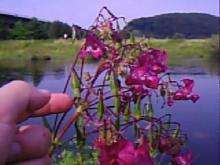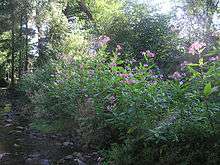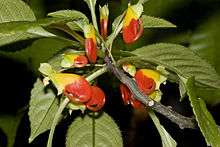Impatiens
| Impatiens | |
|---|---|
 | |
| Impatiens scapiflora at Silent Valley National Park, South India | |
| Scientific classification | |
| Kingdom: | Plantae |
| (unranked): | Angiosperms |
| (unranked): | Eudicots |
| (unranked): | Asterids |
| Order: | Ericales |
| Family: | Balsaminaceae |
| Genus: | Impatiens L. |
| Species | |
|
850–1,000; see text | |
Impatiens /ɪmˈpeɪʃəns/[1] is a genus of about 850 to 1,000 species of flowering plants, widely distributed throughout the Northern Hemisphere and the tropics. Together with the genus Hydrocera, Impatiens make up the family Balsaminaceae.
Common names include impatiens, jewelweed, touch-me-not, snapweed, patience, and, for I. walleriana in Great Britain, "busy lizzie", as well as, ambiguously, balsam. As a rule-of-thumb, "jewelweed" is used exclusively for Nearctic species, "balsam" is usually applied to tropical species, and "touch-me-not" is typically used in Europe and North America.[2]
Description

Some species are annual plants and produce flowers from early summer until the first frost, while perennial species, found in milder climates, can flower all year. Regardless of their lifespan, the largest impatiens grow up to about 2 meters (about 7 feet) tall, but most are less than half as tall. The leaves are entire and shiny; their upperside has a thick, water-repellent cuticula that gives them a greasy feel. Particularly on the underside of the leaves, tiny air bubbles are trapped over and under the leaf surface, giving them a silvery sheen that becomes pronounced when they are held under water.
The flowers, up to 2–3 cm, around 1 inch long, in most species are made up by a shoe- or horn-shaped spur for the most part, with at least the upper petals insignificant by comparison; some have a prominent labellum though, allowing pollinators to land. Others, like the busy lizzie (I. walleriana), have flattened flowers with large petals and just a tiny spur that appear somewhat similar to those of violets (Viola), an unrelated genus. A few Impatiens species have flowers intermediate between the two basic types.
The scientific name Impatiens (Latin for "impatient") and the common name "touch-me-not" refer to the explosive dehiscence of the seed capsules. The mature capsules burst, sending seeds up to several meters away.
Ecology and distribution
Balsams grow both in and out of direct sunlight; they prefer moist, rich soils, like roadside ditches, reed beds, fens, river banks and forest edges, and many are well able to colonize disturbed ruderal locations.
Impatiens foliage is used for food by the larvae of some Lepidoptera species, such as the dot moth (Melanchra persicariae), as well as other insects, such as the Japanese beetle (Popillia japonica). Some bees also use jewelweed as a source for nectar and pollen. One such species is Bombus terricola, which consistently forages on jewelweed as well as milkweed and fireweed.[3] The leaves are toxic to many other animals, including the budgerigar (Melopsittacus undulatus), but the bird will readily eat the flowers. The flowers are also visited by bumblebees and certain Lepidoptera, such as the common spotted flat (Celaenorrhinus leucocera).
Parasitic plants that use impatiens as hosts include the European dodder (Cuscuta europaea). A number of plant diseases affect this genus.

In the 19th and 20th centuries, humans transported the orange jewelweed (I. capensis) to England, France, the Netherlands, Poland, Sweden, Finland, and potentially other areas of Northern and Central Europe. For example, it was not recorded from Germany as recently as 1996,[4] but since then a population has naturalized in Hagen at the Ennepe River. The orange jewelweed is quite similar to the touch-me-not balsam (I. noli-tangere), the only Impatiens species native to Central and Northern Europe, and it utilizes similar habitats, but no evidence exists of natural hybrids between them. Small balsam (I. parviflora), originally native to southern Central Asia, is even more extensively naturalized in Europe. More problematic is the Himalayan balsam (I. glandulifera), a densely growing species which displaces smaller plants by denying them sunlight. It is an invasive weed in many places, and tends to dominate riparian vegetation along polluted rivers and nitrogen-rich spots. Thus, it exacerbates ecosystem degradation by forming stands where few other plants can grow, and by rendering riverbanks more prone to erosion, as it has only a shallow root system.
The starkly differing flower shapes found in this genus, combined with the easy cultivation of many species, have served to make some balsam species model organisms in plant evolutionary developmental biology. Also, Impatiens is rather closely related to the carnivorous plant families Roridulaceae and Sarraceniaceae. Peculiar stalked glands found on balsam sepals secrete mucus and might be related to the structures from which the prey-catching and -digesting glands of these carnivorous plants evolved. Balsams are not known to be protocarnivorous plants, however.
In 2011-2013, the United States experienced a significant outbreak of the fungal disease downy mildew that affects impatiens, particularly Impatiens walleriana.[5] The disease was also reported in Canada as well.[6] The pathogen plasmopara obducens is the chief culprit suspected by scientists,[7] but Bremiella sphaerosperma is related.[8] These pathogens were first reported in the United States in 2004.[9][10]
Medicinal uses and phytochemistry
Impatiens contain 2-methoxy-1,4-naphthoquinone, an anti-inflammatory and fungicide naphthoquinone that is an active ingredient in some formulations of Preparation H.[11]
North American impatiens have been used as herbal remedies for the treatment of bee stings, insect bites, and stinging nettle (Urtica dioica) rashes. They are also used after poison ivy (Toxicodendron radicans) contact to prevent a rash from developing. The efficacy of orange jewelweed (I. capensis) and yellow jewelweed (I. pallida) in preventing poison ivy contact dermatitis has been studied, with conflicting results.[12] A study in 1958 found that Impatiens biflora was an effective alternative to standard treatment for dermatitis caused by contact with sumac,[13] while later studies[14][15][16] found that the species had no antipruritic effects after the rash has developed. Researchers reviewing these contradictions[12] state that potential reason for these conflicts include the method of preparation and timing of application. A 2012 study found that while an extract of orange jewelweed and garden jewelweed (I. balsamina) was not effective in reducing contact dermatitis, a mash of the plants applied topically decreased it.[17]
Impatiens glandulifera is one of the Bach flower remedies, flower extracts used as herbal remedies for physical and emotional problems. It is included in the "Rescue Remedy" or "Five Flower Remedy", a potion touted as a treatment for acute anxiety and which is supposed to be protective in stressful situations. Studies have found no difference between the effect of the potion and that of a placebo.[18]
All Impatiens taste bitter and seem to be slightly toxic upon ingestion, causing intestinal ailments like vomiting and diarrhea. The toxic compounds have not been identified but are probably the same as those responsible for the bitter taste, likely might be glycosides or alkaloids.
α-Parinaric acid, a polyunsaturated fatty acid discovered in the seeds of the makita tree (Atuna racemosa racemosa), is together with linolenic acid the predominant component of the seed fat of garden jewelweed (I. balsamina), and perhaps other species of Impatiens.[19] This is interesting from a phylogenetic perspective, because the makita tree is a member of the Chrysobalanaceae in a lineage of eudicots entirely distinct from the balsams.
Certain jewelweeds, including the garden jewelweed contain the naphthoquinone lawsone, a dye that is also found in henna (Lawsonia inermis) and is also the hair coloring and skin coloring agent in mehndi. In ancient China, Impatiens petals mashed with rose and orchid petals and alum were used as nail polish: leaving the mixture on the nails for some hours colored them pink or reddish.
Impatiens has been listed as one of the 38 plants that are used to prepare Bach flower remedies,[20] a kind of alternative medicine promoted for its effect on health. However according to Cancer Research UK, "there is no scientific evidence to prove that flower remedies can control, cure or prevent any type of disease, including cancer".[21]
Cultivation

Impatiens are popular garden annuals. Hybrids, typically derived from busy lizzie (I. walleriana) and New Guinea impatiens (I. hawkeri), have commercial importance as garden plants. I. walleriana is native to East Africa,[22] and yielded 'Elfin' series of cultivars, which was subsequently improved as the 'Super Elfin' series. Double-flowered cultivars also exist.

Other Impatiens species, such as African queen (I. auricoma), garden jewelweed (I. balsamina), blue diamond impatiens (I. namchabarwensis), parrot flower (I. psittacina), Congo cockatoo (I. niamniamensis), Ceylon balsam (I. repens), and poor man's rhododendron (I. sodenii), are also used as ornamental plants.
Selected species




|
|
Footnotes
- ↑ Sunset Western Garden Book, 1995:606–607
- ↑ RHS A-Z Encyclopedia of Garden Plants. United Kingdom: Dorling Kindersley. 2008. p. 1136. ISBN 1405332964.
- ↑ Heinrich, Bernd; Mudge, Patricia; Deringis, Pamela (1977). "Laboratory Analysis of Flower Constancy in Foraging Bumblebees: Bombus ternarius and B. terricola". Behavioral Ecology and Sociobiology (2): 247–296.
- ↑ Bäßler, M., et al. (1996): Springkraut – Impatiens L.. In: Exkursionsflora von Deutschland (Band 2 – Gefäßpflanzen: Grundband) ["Excursion flora of Germany (Vol. 2 – Vascular plants: basic volume)"]: 323 [in German]. Gustav Fischer Verlag, Jena and Stuttgart.
- ↑ http://articles.chicagotribune.com/2013-04-22/news/ct-met-impatiens-disease-20130422_1_downy-mildew-plants-disease
- ↑ http://blogs.vancouversun.com/2013/07/31/killer-fungal-disease-wipes-out-b-c-s-impatiens/
- ↑ http://msue.anr.msu.edu/news/impatiens_downy_mildew_a_curse_and_opportunity_for_your_garden
- ↑ http://nt.ars-grin.gov/taxadescriptions/factsheets/index.cfm?thisapp=Plasmoparaobducens
- ↑ http://jacksonville.com/entertainment/home-and-garden/2015-05-22/story/garden-qa-you-might-be-getting-impatient-about
- ↑ http://www.apsnet.org/publications/plantdisease/2013/March/Pages/97_3_428.1.aspx
- ↑ Brill & Dean. Identifying and Harvesting Edible and Medicinal Plants in Wild (and Not-So-Wild) Places. William Morrow/Harper Collins Publishers, New York, 1994.
- 1 2 Benzie, I. F. F. and S. Wachtel-Galor, editors. Herbal Medicine: Biomolecular and Clinical Aspects. 2nd edition. Boca Raton, Florida: CRC Press. 2011.
- ↑ Lipton, R. A. (Sep–Oct 1958). "The use of Impatiens biflora (jewelweed) in the treatment of rhus dermatitis.". Annals of Allergy. 16 (5): 526–7. PMID 13583762.
- ↑ Long, D., et al. (1997).Treatment of poison ivy/oak allergic contact dermatitis with an extract of jewelweed. Am. J. Contact. Dermat. 8(3) 150-3. PMID 9249283
- ↑ Gibson, M. R. and F. T. Maher. (1950). Activity of jewelweed and its enzymes in the treatment of Rhus dermatitis. J. Am. Pharm. Assoc. Am. Pharm. Assoc. 39(5) 294-6. PMID 15421925
- ↑ Zink, B. J., et al. (1991). The effect of jewel weed in preventing poison ivy dermatitis. Journal of Wilderness Medicine 2(3), 178-182.
- ↑ Motz, V. A., et al. (2012). The effectiveness of jewelweed, Impatiens capensis, the related cultivar I. balsamina and the component, lawsone in preventing post poison ivy exposure contact dermatitis. Journal of Ethnopharmacology 143(1) 314–18.
- ↑ Thaler, K., et al. (2009). Bach Flower Remedies for psychological problems and pain: a systematic review. BMC Complementary and Alternative Medicine 9(1) 16.
- ↑ Gunstone, F. D. Fatty Acid and Lipid Chemistry. Springer. 1996. p.10.
- ↑ D. S. Vohra (1 June 2004). Bach Flower Remedies: A Comprehensive Study. B. Jain Publishers. p. 3. ISBN 978-81-7021-271-3. Retrieved 2 September 2013.
- ↑ "Flower remedies". Cancer Research UK. Retrieved September 2013. Check date values in:
|access-date=(help) - ↑ Ombrello, T. Impatiens wallerana. Union County College Faculty Websites.
- 1 2 3 4 5 6 7 8 9 10 Suksathan, P. and P. Triboun. 2009. Ten new species of Impatiens (Balsaminaceae) from Thailand. Gardens’ Bulletin Singapore 61(1): 159-84.
- 1 2 3 Shimizu, T. 2000. New species of the Thai Impatiens (Balsaminaceae): 2. Bulletin of the National Science Museum, Ser. B (Botany). Tokyo, Vol. 26: 35-42.
- ↑ Moore, G., P. F. Zika, and C. A. Rushworth. (2012). Impatiens ecornuta, a new name for Impatiens ecalcarata (Balsaminaceae), a jewelweed from the United States and Canada. Novon: A Journal for Botanical Nomenclature 22(1) 60-1.
- ↑ Cheek, M. and E. Fischer. (1999). A tuberous and epiphytic new species of Impatiens (Balsaminaceae) from southwest Cameroon. Kew Bulletin 54(2) 471-75.
- ↑ Janssens, S. B., et al. (2009). Impatiens msisimwanensis (Balsaminaceae): Description, pollen morphology and phylogenetic position of a new East African species. South African Journal of Botany 75(1) 104-09.
- 1 2 3 Shimizu, T. and P. Suksathan. 2004. Three new species of the Thai Impatiens (Balsaminaceae). Part 3. Bulletin of the National Science Museum, Ser. B (Botany). Tokyo, Vol. 30(4): 165-71.
- ↑ Impatiens scapiflora. Germplasm Resources Information Network (GRIN).
- ↑ Fischer, E. and M. E. Rahelivololona. (2004). A new epiphytic species of Impatiens (Balsaminaceae) from the Comoro Islands. Adansonia 25, 93-95.
References
- Guin, J.D. & Reynolds, R. (1980): Jewelweed treatment of poison ivy dermatitis. Contact Dermatitis 6(4): 287–288. doi:10.1111/j.1600-0536.1980.tb04935.x
- Forest Herbarium (BKF). 2010. The Encyclopedia of Plants in Thailand, Balsaminaceae in Thailand (เทียน in Thai)
Further references
Hepper, J.Nigel (Ed) 1982. Royal Botanic Gardens Kew Gardens for Science & Pleasure. London. Her Majesty's Stationery Office. ISBN 0 11 241181 9
External links
| Wikimedia Commons has media related to Impatiens. |
| Wikispecies has information related to: Impatiens |
- Flora of China: Impatiens species list
- Flora Europaea: Impatiens
- Flora of Madagascar: Impatiens species list
- Jewelweed, from Identifying and harvesting edible and medicinal plants in wild (and not-so-wild) places
- Impatiens: the vibrant world of Busy Lizzies, Balsams, and Touch-me-nots
- UK National Plant Collection of Impatiens
- Dressler, S.; Schmidt, M. & Zizka, G. (2014). [http://www.africanplants.senckenberg.de/root/index.php?submitForm=true&page_id=77&searchTextMenue=Impatiens&filterRegionIDs[]=6&filterRegionIDs[]=1&filterRegionIDs[]=2&filterRegionIDs[]=3&filterRegionIDs[]=5 "Impatiens"]. African plants – a Photo Guide. Frankfurt/Main: Forschungsinstitut Senckenberg.

